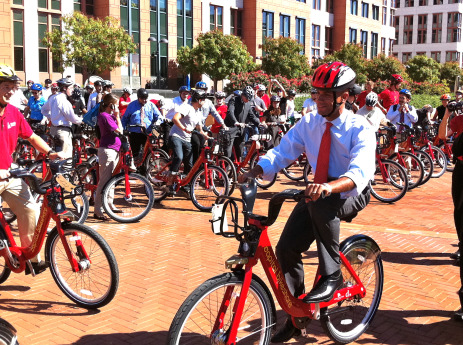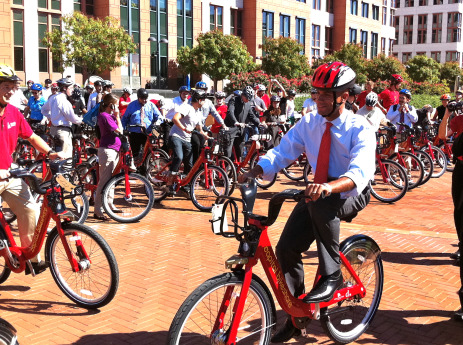 Washington’s mayor, Adrian Fenty, takes a test spin on one of the city’s new shared bikes.Photo: Matt MartinezIf you want to see what a good bike share system can do for a city, go to Lyon, France. I just returned from a week-long visit, and the bikes were coming and going the minute I stepped out of the door: A man in a suit with groceries from the corner market (it looked like bread, milk, and some flowers). German tourists yakking away while riding along the banks of the Rhone River. Students zipping through the Place Bellecour on their way to class, or to meet friends at a café. It made the city feel alive. And it made me wish that D.C.’s bike share system were as vibrant and useful as Lyon’s.
Washington’s mayor, Adrian Fenty, takes a test spin on one of the city’s new shared bikes.Photo: Matt MartinezIf you want to see what a good bike share system can do for a city, go to Lyon, France. I just returned from a week-long visit, and the bikes were coming and going the minute I stepped out of the door: A man in a suit with groceries from the corner market (it looked like bread, milk, and some flowers). German tourists yakking away while riding along the banks of the Rhone River. Students zipping through the Place Bellecour on their way to class, or to meet friends at a café. It made the city feel alive. And it made me wish that D.C.’s bike share system were as vibrant and useful as Lyon’s.
Well, it didn’t take long for my wish to come true — sort of. Shortly after I got back to the States I learned that the District was scrapping its old bike share system and debuting a new, expanded regional one.
Washington D.C. and Arlington County debuted Capital Bikeshare today. It’s the largest bike sharing program in the United States — 1,100 bikes at 100 kiosks in the District and Northern Virginia. (Denver and Minneapolis are the other two cities in the US with significant bike share programs.)
The previous iteration of the District’s bike share system, SmartBike, launched in 2008. Operated by Clear Channel Communications, it never really caught fire. There are lots of reasons for that: not enough bikes, not enough bike stations, and, remarkably, very little marketing. (I am not the first to note the irony of poor marketing for a service operated by an advertising company.)
One of the biggest reasons it didn’t catch on, though, was that you could only use the bikes if you signed up for a yearly $40 subscription fee. It was an immediate impediment for folks who only wanted to use the service a couple of times a year, or for people visiting D.C. for a couple of days. Tourists were out of luck.
This new service changes all of that. You can sign up for an introductory yearly rate of $50, which will go up to $75, or you can sign up for a $5 day pass.
Capital Bikeshare is modeled on the bike share service in Montréal. It’s a public-private partnership — funded by user fees and operated and maintained with private companies. D.C.’s program is operated by Alta Bike Sharing, based in Portland, Ore.
Montreal’s bike program — called Bixi — was inspired by Europe’s most successful and, at the time it was started, largest bike share program, Vélo’v, in Lyon. (The name is a portmanteau of the French word for bike vélo and the English word love.)
Vélo’v is considered a watershed in bike sharing “schemes,” as they call them in Europe. It flooded the city with thousands of bikes, and it seems as though there are bike stations on nearly every other block. Before the program, Lyon wasn’t considered a particularly bike-friendly city. Since the introduction, though, officials there say shared bikes have increased bike use by 500 percent. They have also tamed drivers. No other city achieved higher success until Paris started its program, Vélib’, which now has more than 20,000 bikes across the city. (Vélib’ is a portmanteau of vélo and liberté — the French do love their portmanteaus!)
The District will have nowhere near the amount of bikes in Lyon, Paris, or even Montréal. But Gabe Klein, D.C.’s Director of Transportation, wants to increase the number of bikes to 2,200 within a year.
“With this system,” Klein told me, “We can assemble and drop it in a matter of a few hours. And then we can expand it, we can move it.”
That’s an important part of this project — the ability to move bikes and kiosks quickly to meet the demands of a city constantly in flux. Summertime will demand more bikes near the National Mall than, say, American University in upper Northwest D.C. The new system allows the city to adapt to these traffic patterns and for the bikes to remain a dynamic part of the city’s transportation plan.
I wanted to check out the bikes on their first morning, so I hopped on my own bike and rode down Pennsylvania Avenue to the Department of Transportation. There, D.C. Mayor Adrian Fenty kicked off the program.
“We are staking our claim,” said Fenty. “And we are going after Montréal and anywhere else in the country — in the world! — that may have a little bit more bicycles than we.”
Like I said before, D.C. has a long way to go before it can match the success of other bike share programs. Still, as I looked out across hundreds of gleaming red and yellow bikes lined up on a plaza behind the DOT, it wasn’t hard to imagine the city someday being on par with Montreal, Paris, or Lyon. Just before the mayor hopped on his bike for a short ride, a young guy in a Capital Bikeshare t-shirt walked past me and said, “Cool, huh?” And all I could respond was, “Yeah, very cool.”
See Capital Bikeshare in Action: Go to their Youtube page to see a promotional video. They also have a Twitter feed and, of course, an app for iPhone, Blackberry, and Android.
But it’s not all wine and roses! Listen to this NPR report about Paris’ bike share vandalism problem.



